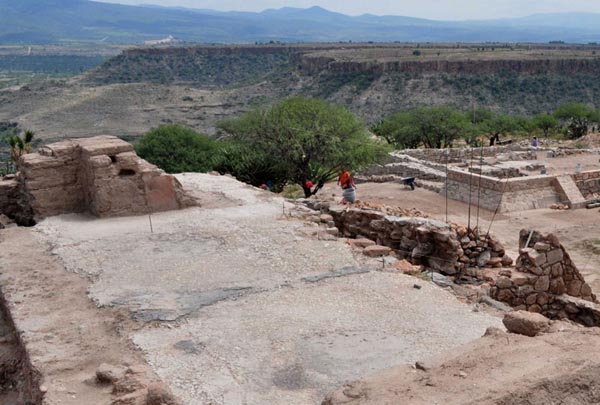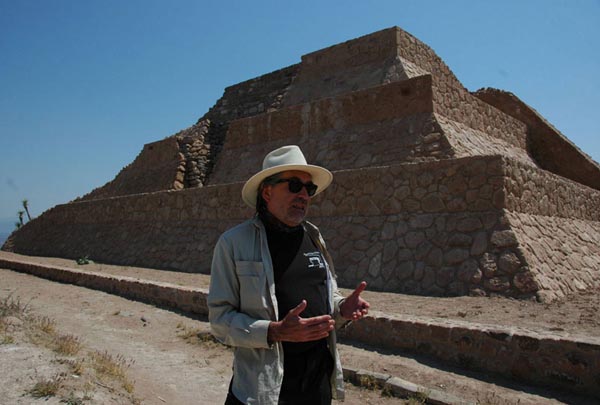Seventh century eclipse marked the end of temple site
Source: pasthorizonspr.com

During excavations at Pañhú, in Hidalgo Tecozautla, Mexico archaeologists uncovered a burned stucco floor. What they had found was evidence that the main pyramid had been deliberately ‘de-consecrated‘ and destroyed approximately 1350 years ago.
A global disaster
This deliberate act coincides with an astronomical occurrence which may have been interpreted by the Otomi people as warning of a global cataclysmic event.
One of the early complex cultures of Mesoamerica, the Otomi are suspected to be the original inhabitants of the central Mexican Altiplano before the arrival of Nahua people around 1000 CE.
Archaeologist Fernando López Aguilar, director of the research project led by the National Institute of Anthropology and History (INAH) realised there may be a correlation between the evidence for burning of the temple on the upper pyramid platform and an eclipse of the sun at dawn on 3 August, 650 CE.
Solar annular eclipse and Huehuetéotl - the elderly god of fire. Images: Wikimedia
Seventh century eclipse marked the end of temple site
During excavations at Pañhú, in Hidalgo Tecozautla, Mexico archaeologists uncovered a burned stucco floor. What they had found was evidence that the main pyramid had been deliberately ‘de-consecrated‘ and destroyed approximately 1350 years ago.
The burnt stucco floor, clearly showing the scorched areas. Image: INAH
The burnt stucco floor, clearly showing the scorched areas. Image: INAH
A global disaster
This deliberate act coincides with an astronomical occurrence which may have been interpreted by the Otomi people as warning of a global cataclysmic event.
One of the early complex cultures of Mesoamerica, the Otomi are suspected to be the original inhabitants of the central Mexican Altiplano before the arrival of Nahua people around 1000 CE.
Archaeologist Fernando López Aguilar, director of the research project led by the National Institute of Anthropology and History (INAH) realised there may be a correlation between the evidence for burning of the temple on the upper pyramid platform and an eclipse of the sun at dawn on 3 August, 650 CE.

The burnt stucco floor, clearly showing the scorched areas.

Archaeologist Fernando López, Director of the Proyecto Arqueológico Pahñú.

The newly restored site of Pahñú where the Eclipse took place at dawn on the 3rd August 650 CE.
López Aguilar explained that; “To these ancient societies, the eclipse represented a catastrophe and performed sacrifices in order to ‘keep the sun alive’, because for them the black sun or the underworld sun had imposed itself on the life-giving sun.”
This particular event has been suggested as also leading to a gradual decline in the great city of Teotihuacan and at Pañhú it also had its implications.
This phenomenon, said López Aguilar, was taken to be the harbinger of the end of a cycle, and the inhabitants proceeded to Pañhú’s main pyramid on the edge of the plateau where the site is located, and undertook major works to recover foundation offerings, most likely to the old fire God, known as Otontecuhtli (also known as Huehuetéotl or Xiuhtecuhtli).
After they razed the temple at the top of the pyramid and burnt the area they began performing human sacrifices. During excavations on the stucco floor the team found fragments of human skulls and Agave americana spikes that the priests would have used for auto-sacrifice.
A new temple
On what was left of the structure dating to between 400-650 CE, there rose another very different style of architecture in keeping with the new period called Epi-Classic (650-900 CE). In the Huichapan region where Pañhú and several other settlements are located they maintained their extensive networks of economic links, which is confirmed by the discovery of turquoise from New Mexico, jadeite from the Motagua Valley (Guatemala) and shells from the Gulf of Mexico.
This area was the setting for the creation myth of the latest cycle of time – one of the most important myths of Mesoamerica.
According to Aztec legend, Coatlicue was magically impregnated by hummingbird feathers that fell on her while she was sweeping a temple and she subsequently gave birth to the gods Quetzalcoatl and Xolotl. Her previous daughter Coyolxauhqui called on Coatlicue’s four hundred other children and convinced them into attacking and decapitating their mother.
The instant she was killed, the god Huitzilopochtli emerged from her womb fully grown and armed for battle. In the ensuing battle he killed many of his brothers and sisters, including Coyolxauhqui, whose head he cut off and threw into the sky to become the moon.
This conflict gave rise to the name of the region, ‘Teotlalpan – the land of the gods’.
[...]
Read the full article at: pasthorizonspr.com






















